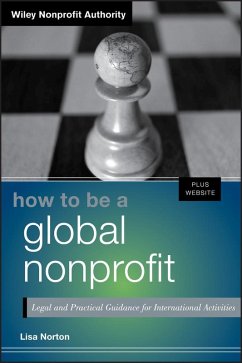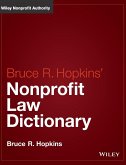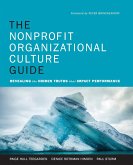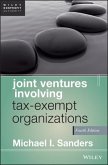Lisa Norton
Global Nonprofit + WS
Lisa Norton
Global Nonprofit + WS
- Gebundenes Buch
- Merkliste
- Auf die Merkliste
- Bewerten Bewerten
- Teilen
- Produkt teilen
- Produkterinnerung
- Produkterinnerung
Solid guidance for the complex legal issues faced by international nonprofits
When a nonprofit operates across borders, whether by making grants or directly operating programs, the interaction among legal requirements of two or more countries quickly becomes highly complex. How To Be A Global Nonprofit fills a need for legal and practical guidance for nonprofit organizations with international activities, and includes ten case studies to provide insights into the ways real organizations have dealt with various legal and practical issues.
Along the way, it skillfully explores alternatives…mehr
Andere Kunden interessierten sich auch für
![Hopkins' Nonprofit Law Dictionary Hopkins' Nonprofit Law Dictionary]() Bruce R. HopkinsHopkins' Nonprofit Law Dictionary100,99 €
Bruce R. HopkinsHopkins' Nonprofit Law Dictionary100,99 €![Good Counsel Good Counsel]() Lesley RosenthalGood Counsel83,99 €
Lesley RosenthalGood Counsel83,99 €![The Nonprofit Development Companion The Nonprofit Development Companion]() Brydon M. DeWittThe Nonprofit Development Companion48,99 €
Brydon M. DeWittThe Nonprofit Development Companion48,99 €![The Nonprofit Organizational Culture Guide The Nonprofit Organizational Culture Guide]() Paige Hull TeegardenThe Nonprofit Organizational Culture Guide48,99 €
Paige Hull TeegardenThe Nonprofit Organizational Culture Guide48,99 €![Joint Ventures Involving Tax-Exempt Organizations Joint Ventures Involving Tax-Exempt Organizations]() Michael I. SandersJoint Ventures Involving Tax-Exempt Organizations280,99 €
Michael I. SandersJoint Ventures Involving Tax-Exempt Organizations280,99 €![The Money-Raising Nonprofit Brand The Money-Raising Nonprofit Brand]() Jeff BrooksThe Money-Raising Nonprofit Brand52,99 €
Jeff BrooksThe Money-Raising Nonprofit Brand52,99 €![Finance Fundamentals for Nonprofits, with Website Finance Fundamentals for Nonprofits, with Website]() Woods BowmanFinance Fundamentals for Nonprofits, with Website66,99 €
Woods BowmanFinance Fundamentals for Nonprofits, with Website66,99 €-
-
-
Solid guidance for the complex legal issues faced by international nonprofits
When a nonprofit operates across borders, whether by making grants or directly operating programs, the interaction among legal requirements of two or more countries quickly becomes highly complex. How To Be A Global Nonprofit fills a need for legal and practical guidance for nonprofit organizations with international activities, and includes ten case studies to provide insights into the ways real organizations have dealt with various legal and practical issues.
Along the way, it skillfully explores alternatives for advancing a nonprofit's mission across borders, while also looking at the legal and practical issues nonprofits encounter as they work internationally.
Includes ten case studies based on interviews with large and small international nonprofits
Offers a realistic sense of the complexity of legal and practical issues global nonprofits face
Features a companion website with a variety of online tools and materials related to key concepts discussed in this book
Not long ago international philanthropy was the province of large organizations like the Red Cross, UNICEF, and Save the Children. This has radically changed. How to Be a Global Nonprofit thoroughly explores the legal and practical issues nonprofits encounter as they work internationally and the resources required to deal with them.
Hinweis: Dieser Artikel kann nur an eine deutsche Lieferadresse ausgeliefert werden.
When a nonprofit operates across borders, whether by making grants or directly operating programs, the interaction among legal requirements of two or more countries quickly becomes highly complex. How To Be A Global Nonprofit fills a need for legal and practical guidance for nonprofit organizations with international activities, and includes ten case studies to provide insights into the ways real organizations have dealt with various legal and practical issues.
Along the way, it skillfully explores alternatives for advancing a nonprofit's mission across borders, while also looking at the legal and practical issues nonprofits encounter as they work internationally.
Includes ten case studies based on interviews with large and small international nonprofits
Offers a realistic sense of the complexity of legal and practical issues global nonprofits face
Features a companion website with a variety of online tools and materials related to key concepts discussed in this book
Not long ago international philanthropy was the province of large organizations like the Red Cross, UNICEF, and Save the Children. This has radically changed. How to Be a Global Nonprofit thoroughly explores the legal and practical issues nonprofits encounter as they work internationally and the resources required to deal with them.
Hinweis: Dieser Artikel kann nur an eine deutsche Lieferadresse ausgeliefert werden.
Produktdetails
- Produktdetails
- Wiley Nonprofit Authority
- Verlag: Wiley & Sons
- 1. Auflage
- Seitenzahl: 320
- Erscheinungstermin: 25. Februar 2013
- Englisch
- Abmessung: 236mm x 156mm x 32mm
- Gewicht: 512g
- ISBN-13: 9781118452226
- ISBN-10: 1118452224
- Artikelnr.: 36550310
- Herstellerkennzeichnung
- Libri GmbH
- Europaallee 1
- 36244 Bad Hersfeld
- gpsr@libri.de
- Wiley Nonprofit Authority
- Verlag: Wiley & Sons
- 1. Auflage
- Seitenzahl: 320
- Erscheinungstermin: 25. Februar 2013
- Englisch
- Abmessung: 236mm x 156mm x 32mm
- Gewicht: 512g
- ISBN-13: 9781118452226
- ISBN-10: 1118452224
- Artikelnr.: 36550310
- Herstellerkennzeichnung
- Libri GmbH
- Europaallee 1
- 36244 Bad Hersfeld
- gpsr@libri.de
LISA NORTON is an attorney whose law practice concentrates on serving a wide variety of nonprofit and tax-exempt organizations, helping organizations and donors to pursue their missions through proper structuring and legal compliance. Previously, she served as international tax counsel to several multinational corporations. She is a graduate of Harvard Law School and a member of the bar of the states of Washington, California, and New York. Lisa participates in various bar association committees and professional organizations that concentrate on nonprofit-related issues, and she has served on governing boards and committees of numerous charitable organizations and professional associations. Visit her website at www.lnortonlaw.com, and follow her on Twitter @GlobalNonprofit.
List of Case Studies xiii
Preface xv
How to Use This Book xviii
Disclaimer xix
Internal Revenue Service Circular 230 Disclosure xx
Acknowledgments xxiii
Chapter 1 So You Want to Be a Global Nonprofit? 1
1.1 What Do You Really Want to Accomplish? 1
1.2 Spectrum of International Activities 2
1.3 Overview of International Grantmaking 3
1.4 Directly Operating Foreign Programs 12
1.5 Global Fundraising 17
1.6 Legal Considerations: A Basic Framework 17
1.7 The Importance of Vigilance 25
1.8 So, You Still Want to Be a Global Nonprofit? 27
Chapter 2 International Grantmaking by Public Charities 29
2.1 Public Charity or Private Foundation: Why Does It Matter? 30
2.2 What is a Public Charity? 30
2.3 Basic Rules for Foreign Grantmaking 32
2.4 American Friends of Organizations 39
2.5 Special Rules for Donor-Advised Funds 39
2.6 Other U.S. Intermediaries 40
2.7 Review and Further Considerations 40
Chapter 3 International Grantmaking by Private Foundations 43
3.1 What is a Private Foundation? 43
3.2 Should a Private Foundation Make Cross-Border Grants? 45
3.3 Permitted Grants and Disbursements 45
3.4 International Grantmaking: Special Requirements for Private Foundations
48
3.5 U.S. Withholding Tax on Disbursements of Grant Funds 52
3.6 Review and Further Considerations 52
Chapter 4 Going Deeper: Operating a Foreign Program 55
4.1 Are You Determined to Move Beyond Grantmaking? 55
4.2 Is Anybody Else Doing It? 56
4.3 Are You Sure You Will Be Allowed to Do What You Want to Do? 58
4.4 Alternative Models for Operating a Foreign Program 59
4.5 Establishing a Foreign Office 60
4.6 Do You Need to Do It Alone? 66
4.7 Staffing a Foreign Office: Consequences to the Organization 69
4.8 Will Your U.S. Organization Be Taxed by a Foreign Country? 70
4.9 What Happens If Your Organization Conducts Business Activities in a
Foreign Country? 76
4.10 Foreign Reporting Requirements 79
4.11 U.S. Reporting Requirements 79
4.12 Review and Further Considerations 79
Chapter 5 Forming and Operating through a Foreign Legal Entity 85
5.1 Establishing a Foreign Legal Entity 85
5.2 How Hard Will It Be to Form a Foreign Legal Entity? 93
5.3 What Kind of Legal Entity Should You Create, and Why Should You Care?
94
5.4 Do You Want a Model of Control or Collaboration, or Both? 102
5.5 Control 103
5.6 Collaboration 107
5.7 Two Case Studies: One Very Large and One Very Small Organization 108
5.8 Headquarters Offices: Centralized versus Decentralized Services 112
5.9 Shared Employees 120
5.10 Will a Foreign Legal Entity Be Tax-Exempt in Its Local Country? 121
5.11 Will a Foreign Legal Entity Be Taxed in the United States? 123
5.12 The Importance of Keeping U.S. and Foreign Activities Separate 125
5.13 Consider the Burdens of Maintaining Two or More Separate Legal
Entities 126
5.14 For-Profit Subsidiaries 127
5.15 Soliciting Funds from U.S. Donors 127
5.16 Review and Further Considerations 128
Chapter 6 Staffing Foreign Operations: Employees and Volunteers 133
6.1 Staffing Foreign Operations: Will You Send U.S. Staff or Hire Locally?
133
6.2 Sending People Overseas: Initial Considerations 134
6.3 If You Send U.S. Employees to Work in a Foreign Country, Will They Be
Taxed There? 135
6.4 If Your Employees Are Taxed in a Foreign Country, Will They Still Be
Taxed in the United States? 137
6.5 Making Payments to People Working in Foreign Countries 141
6.6 Hiring Locally 142
6.7 Hiring or Sending Non-U.S. Citizens/Residents to Work in the United
States 143
6.8 Special Considerations for Volunteers 146
6.9 Review and Further Considerations 148
Chapter 7 Raising Funds Globally 153
7.1 Why Do You Want to Raise Funds in a Foreign Country? 153
7.2 Will You Be Permitted to Solicit Contributions in a Foreign Country?
154
7.3 Does the Foreign Country Provide Tax Benefits, and Are They Important
to Your Donors? 155
7.4 Is a Separate Legal Entity Required? 156
7.5 Tax Benefits for Cross-Border Philanthropy 158
7.6 Exceptions to the Separate Legal Entity Requirement for Fundraising in
Foreign Countries 162
7.7 Structuring Relationships among Fundraising and Operating Entities 166
7.8 Keep It as Simple as Possible 167
7.9 Review and Further Considerations 168
Chapter 8 Additional U.S. Laws and Reporting Requirements 173
8.1 Anti-Terrorism Compliance 173
8.2 Export Controls 181
8.3 Anti-Boycott Rules 182
8.4 Anti-Bribery Rules 184
8.5 Lobbying and Political Activity 188
8.6 Foreign Funding of Lobbying and Propaganda 193
8.7 U.S. Individuals Working in Foreign Countries 193
8.8 Non-U.S. Individuals Working in the U.S.: Verifying Legal Status 194
8.9 Financial Reporting 195
8.10 U.S. Tax Reporting of Foreign Activities 195
8.11 U.S. Tax Withholding on Payments to Non-U.S. Citizens or Residents 197
8.12 Reporting of Foreign Financial Assets 202
8.13 Review and Further Considerations 204
Chapter 9 Additional Foreign Legal and Practical Considerations 211
9.1 Finding the Right Local Counsel 211
9.2 Anti-Terrorism Restrictions 213
9.3 Restrictions on Cross-Border Funding 215
9.4 Restrictions on Sending Goods across Borders 217
9.5 Anti-Bribery Laws and Avoiding Corruption 218
9.6 Restrictions on Political Activity and Lobbying 221
9.7 Protecting Trademarks, Copyrights, and Other Intellectual Property 223
9.8 Data Privacy Laws 229
9.9 Privacy 231
9.10 Managing Multiple Currencies and Currency Controls 232
9.11 International Travel and Security 233
9.12 Insurance Matters 233
9.13 Acquiring Real Estate 234
9.14 Value Added Tax (VAT) 234
9.15 Other (Non-Income) Taxes 236
9.16 Governmental Reporting Requirements: Financial, Tax, and Others 238
9.17 Market and Political Impact of Foreign Direct Services 239
9.18 Review and Further Considerations 239
Chapter 10 Evolution of a Global Organization: Half the Sky Foundation 245
10.1 Seeing a Need and Addressing It with Passion 245
10.2 Half the Sky's Experience in China 247
10.3 Legal Status of HTS in China 252
10.4 What Has HTS Learned about Working in China? 254
10.5 Developing a Global Fundraising Network 255
10.6 Closing Thoughts 259
Appendix A Glossary of Terms 261
Appendix B Additional Resources 271
Resources for 501(c)(3) Organizations 271
Resources for Private Foundations 271
International Activities of Nonprofit Organizations 272
U.S. Intermediary Organizations for
International Grantmaking 272
Resources for Cross-Border Grantmakers 272
Resources for Finding International Collaborators 273
Resources on Foreign Country NGO Laws 273
Avoiding Participation in Corruption (Anti-Bribery) 273
Updates on Anti-Terrorism Policies and Their Impact on Nonprofit
Organizations 274
Intellectual Property 274
Appendix C U.S. Bilateral Income Tax Treaties 275
About the Companion Website 277
About the Author 279
Index 281
Preface xv
How to Use This Book xviii
Disclaimer xix
Internal Revenue Service Circular 230 Disclosure xx
Acknowledgments xxiii
Chapter 1 So You Want to Be a Global Nonprofit? 1
1.1 What Do You Really Want to Accomplish? 1
1.2 Spectrum of International Activities 2
1.3 Overview of International Grantmaking 3
1.4 Directly Operating Foreign Programs 12
1.5 Global Fundraising 17
1.6 Legal Considerations: A Basic Framework 17
1.7 The Importance of Vigilance 25
1.8 So, You Still Want to Be a Global Nonprofit? 27
Chapter 2 International Grantmaking by Public Charities 29
2.1 Public Charity or Private Foundation: Why Does It Matter? 30
2.2 What is a Public Charity? 30
2.3 Basic Rules for Foreign Grantmaking 32
2.4 American Friends of Organizations 39
2.5 Special Rules for Donor-Advised Funds 39
2.6 Other U.S. Intermediaries 40
2.7 Review and Further Considerations 40
Chapter 3 International Grantmaking by Private Foundations 43
3.1 What is a Private Foundation? 43
3.2 Should a Private Foundation Make Cross-Border Grants? 45
3.3 Permitted Grants and Disbursements 45
3.4 International Grantmaking: Special Requirements for Private Foundations
48
3.5 U.S. Withholding Tax on Disbursements of Grant Funds 52
3.6 Review and Further Considerations 52
Chapter 4 Going Deeper: Operating a Foreign Program 55
4.1 Are You Determined to Move Beyond Grantmaking? 55
4.2 Is Anybody Else Doing It? 56
4.3 Are You Sure You Will Be Allowed to Do What You Want to Do? 58
4.4 Alternative Models for Operating a Foreign Program 59
4.5 Establishing a Foreign Office 60
4.6 Do You Need to Do It Alone? 66
4.7 Staffing a Foreign Office: Consequences to the Organization 69
4.8 Will Your U.S. Organization Be Taxed by a Foreign Country? 70
4.9 What Happens If Your Organization Conducts Business Activities in a
Foreign Country? 76
4.10 Foreign Reporting Requirements 79
4.11 U.S. Reporting Requirements 79
4.12 Review and Further Considerations 79
Chapter 5 Forming and Operating through a Foreign Legal Entity 85
5.1 Establishing a Foreign Legal Entity 85
5.2 How Hard Will It Be to Form a Foreign Legal Entity? 93
5.3 What Kind of Legal Entity Should You Create, and Why Should You Care?
94
5.4 Do You Want a Model of Control or Collaboration, or Both? 102
5.5 Control 103
5.6 Collaboration 107
5.7 Two Case Studies: One Very Large and One Very Small Organization 108
5.8 Headquarters Offices: Centralized versus Decentralized Services 112
5.9 Shared Employees 120
5.10 Will a Foreign Legal Entity Be Tax-Exempt in Its Local Country? 121
5.11 Will a Foreign Legal Entity Be Taxed in the United States? 123
5.12 The Importance of Keeping U.S. and Foreign Activities Separate 125
5.13 Consider the Burdens of Maintaining Two or More Separate Legal
Entities 126
5.14 For-Profit Subsidiaries 127
5.15 Soliciting Funds from U.S. Donors 127
5.16 Review and Further Considerations 128
Chapter 6 Staffing Foreign Operations: Employees and Volunteers 133
6.1 Staffing Foreign Operations: Will You Send U.S. Staff or Hire Locally?
133
6.2 Sending People Overseas: Initial Considerations 134
6.3 If You Send U.S. Employees to Work in a Foreign Country, Will They Be
Taxed There? 135
6.4 If Your Employees Are Taxed in a Foreign Country, Will They Still Be
Taxed in the United States? 137
6.5 Making Payments to People Working in Foreign Countries 141
6.6 Hiring Locally 142
6.7 Hiring or Sending Non-U.S. Citizens/Residents to Work in the United
States 143
6.8 Special Considerations for Volunteers 146
6.9 Review and Further Considerations 148
Chapter 7 Raising Funds Globally 153
7.1 Why Do You Want to Raise Funds in a Foreign Country? 153
7.2 Will You Be Permitted to Solicit Contributions in a Foreign Country?
154
7.3 Does the Foreign Country Provide Tax Benefits, and Are They Important
to Your Donors? 155
7.4 Is a Separate Legal Entity Required? 156
7.5 Tax Benefits for Cross-Border Philanthropy 158
7.6 Exceptions to the Separate Legal Entity Requirement for Fundraising in
Foreign Countries 162
7.7 Structuring Relationships among Fundraising and Operating Entities 166
7.8 Keep It as Simple as Possible 167
7.9 Review and Further Considerations 168
Chapter 8 Additional U.S. Laws and Reporting Requirements 173
8.1 Anti-Terrorism Compliance 173
8.2 Export Controls 181
8.3 Anti-Boycott Rules 182
8.4 Anti-Bribery Rules 184
8.5 Lobbying and Political Activity 188
8.6 Foreign Funding of Lobbying and Propaganda 193
8.7 U.S. Individuals Working in Foreign Countries 193
8.8 Non-U.S. Individuals Working in the U.S.: Verifying Legal Status 194
8.9 Financial Reporting 195
8.10 U.S. Tax Reporting of Foreign Activities 195
8.11 U.S. Tax Withholding on Payments to Non-U.S. Citizens or Residents 197
8.12 Reporting of Foreign Financial Assets 202
8.13 Review and Further Considerations 204
Chapter 9 Additional Foreign Legal and Practical Considerations 211
9.1 Finding the Right Local Counsel 211
9.2 Anti-Terrorism Restrictions 213
9.3 Restrictions on Cross-Border Funding 215
9.4 Restrictions on Sending Goods across Borders 217
9.5 Anti-Bribery Laws and Avoiding Corruption 218
9.6 Restrictions on Political Activity and Lobbying 221
9.7 Protecting Trademarks, Copyrights, and Other Intellectual Property 223
9.8 Data Privacy Laws 229
9.9 Privacy 231
9.10 Managing Multiple Currencies and Currency Controls 232
9.11 International Travel and Security 233
9.12 Insurance Matters 233
9.13 Acquiring Real Estate 234
9.14 Value Added Tax (VAT) 234
9.15 Other (Non-Income) Taxes 236
9.16 Governmental Reporting Requirements: Financial, Tax, and Others 238
9.17 Market and Political Impact of Foreign Direct Services 239
9.18 Review and Further Considerations 239
Chapter 10 Evolution of a Global Organization: Half the Sky Foundation 245
10.1 Seeing a Need and Addressing It with Passion 245
10.2 Half the Sky's Experience in China 247
10.3 Legal Status of HTS in China 252
10.4 What Has HTS Learned about Working in China? 254
10.5 Developing a Global Fundraising Network 255
10.6 Closing Thoughts 259
Appendix A Glossary of Terms 261
Appendix B Additional Resources 271
Resources for 501(c)(3) Organizations 271
Resources for Private Foundations 271
International Activities of Nonprofit Organizations 272
U.S. Intermediary Organizations for
International Grantmaking 272
Resources for Cross-Border Grantmakers 272
Resources for Finding International Collaborators 273
Resources on Foreign Country NGO Laws 273
Avoiding Participation in Corruption (Anti-Bribery) 273
Updates on Anti-Terrorism Policies and Their Impact on Nonprofit
Organizations 274
Intellectual Property 274
Appendix C U.S. Bilateral Income Tax Treaties 275
About the Companion Website 277
About the Author 279
Index 281
List of Case Studies xiii
Preface xv
How to Use This Book xviii
Disclaimer xix
Internal Revenue Service Circular 230 Disclosure xx
Acknowledgments xxiii
Chapter 1 So You Want to Be a Global Nonprofit? 1
1.1 What Do You Really Want to Accomplish? 1
1.2 Spectrum of International Activities 2
1.3 Overview of International Grantmaking 3
1.4 Directly Operating Foreign Programs 12
1.5 Global Fundraising 17
1.6 Legal Considerations: A Basic Framework 17
1.7 The Importance of Vigilance 25
1.8 So, You Still Want to Be a Global Nonprofit? 27
Chapter 2 International Grantmaking by Public Charities 29
2.1 Public Charity or Private Foundation: Why Does It Matter? 30
2.2 What is a Public Charity? 30
2.3 Basic Rules for Foreign Grantmaking 32
2.4 American Friends of Organizations 39
2.5 Special Rules for Donor-Advised Funds 39
2.6 Other U.S. Intermediaries 40
2.7 Review and Further Considerations 40
Chapter 3 International Grantmaking by Private Foundations 43
3.1 What is a Private Foundation? 43
3.2 Should a Private Foundation Make Cross-Border Grants? 45
3.3 Permitted Grants and Disbursements 45
3.4 International Grantmaking: Special Requirements for Private Foundations
48
3.5 U.S. Withholding Tax on Disbursements of Grant Funds 52
3.6 Review and Further Considerations 52
Chapter 4 Going Deeper: Operating a Foreign Program 55
4.1 Are You Determined to Move Beyond Grantmaking? 55
4.2 Is Anybody Else Doing It? 56
4.3 Are You Sure You Will Be Allowed to Do What You Want to Do? 58
4.4 Alternative Models for Operating a Foreign Program 59
4.5 Establishing a Foreign Office 60
4.6 Do You Need to Do It Alone? 66
4.7 Staffing a Foreign Office: Consequences to the Organization 69
4.8 Will Your U.S. Organization Be Taxed by a Foreign Country? 70
4.9 What Happens If Your Organization Conducts Business Activities in a
Foreign Country? 76
4.10 Foreign Reporting Requirements 79
4.11 U.S. Reporting Requirements 79
4.12 Review and Further Considerations 79
Chapter 5 Forming and Operating through a Foreign Legal Entity 85
5.1 Establishing a Foreign Legal Entity 85
5.2 How Hard Will It Be to Form a Foreign Legal Entity? 93
5.3 What Kind of Legal Entity Should You Create, and Why Should You Care?
94
5.4 Do You Want a Model of Control or Collaboration, or Both? 102
5.5 Control 103
5.6 Collaboration 107
5.7 Two Case Studies: One Very Large and One Very Small Organization 108
5.8 Headquarters Offices: Centralized versus Decentralized Services 112
5.9 Shared Employees 120
5.10 Will a Foreign Legal Entity Be Tax-Exempt in Its Local Country? 121
5.11 Will a Foreign Legal Entity Be Taxed in the United States? 123
5.12 The Importance of Keeping U.S. and Foreign Activities Separate 125
5.13 Consider the Burdens of Maintaining Two or More Separate Legal
Entities 126
5.14 For-Profit Subsidiaries 127
5.15 Soliciting Funds from U.S. Donors 127
5.16 Review and Further Considerations 128
Chapter 6 Staffing Foreign Operations: Employees and Volunteers 133
6.1 Staffing Foreign Operations: Will You Send U.S. Staff or Hire Locally?
133
6.2 Sending People Overseas: Initial Considerations 134
6.3 If You Send U.S. Employees to Work in a Foreign Country, Will They Be
Taxed There? 135
6.4 If Your Employees Are Taxed in a Foreign Country, Will They Still Be
Taxed in the United States? 137
6.5 Making Payments to People Working in Foreign Countries 141
6.6 Hiring Locally 142
6.7 Hiring or Sending Non-U.S. Citizens/Residents to Work in the United
States 143
6.8 Special Considerations for Volunteers 146
6.9 Review and Further Considerations 148
Chapter 7 Raising Funds Globally 153
7.1 Why Do You Want to Raise Funds in a Foreign Country? 153
7.2 Will You Be Permitted to Solicit Contributions in a Foreign Country?
154
7.3 Does the Foreign Country Provide Tax Benefits, and Are They Important
to Your Donors? 155
7.4 Is a Separate Legal Entity Required? 156
7.5 Tax Benefits for Cross-Border Philanthropy 158
7.6 Exceptions to the Separate Legal Entity Requirement for Fundraising in
Foreign Countries 162
7.7 Structuring Relationships among Fundraising and Operating Entities 166
7.8 Keep It as Simple as Possible 167
7.9 Review and Further Considerations 168
Chapter 8 Additional U.S. Laws and Reporting Requirements 173
8.1 Anti-Terrorism Compliance 173
8.2 Export Controls 181
8.3 Anti-Boycott Rules 182
8.4 Anti-Bribery Rules 184
8.5 Lobbying and Political Activity 188
8.6 Foreign Funding of Lobbying and Propaganda 193
8.7 U.S. Individuals Working in Foreign Countries 193
8.8 Non-U.S. Individuals Working in the U.S.: Verifying Legal Status 194
8.9 Financial Reporting 195
8.10 U.S. Tax Reporting of Foreign Activities 195
8.11 U.S. Tax Withholding on Payments to Non-U.S. Citizens or Residents 197
8.12 Reporting of Foreign Financial Assets 202
8.13 Review and Further Considerations 204
Chapter 9 Additional Foreign Legal and Practical Considerations 211
9.1 Finding the Right Local Counsel 211
9.2 Anti-Terrorism Restrictions 213
9.3 Restrictions on Cross-Border Funding 215
9.4 Restrictions on Sending Goods across Borders 217
9.5 Anti-Bribery Laws and Avoiding Corruption 218
9.6 Restrictions on Political Activity and Lobbying 221
9.7 Protecting Trademarks, Copyrights, and Other Intellectual Property 223
9.8 Data Privacy Laws 229
9.9 Privacy 231
9.10 Managing Multiple Currencies and Currency Controls 232
9.11 International Travel and Security 233
9.12 Insurance Matters 233
9.13 Acquiring Real Estate 234
9.14 Value Added Tax (VAT) 234
9.15 Other (Non-Income) Taxes 236
9.16 Governmental Reporting Requirements: Financial, Tax, and Others 238
9.17 Market and Political Impact of Foreign Direct Services 239
9.18 Review and Further Considerations 239
Chapter 10 Evolution of a Global Organization: Half the Sky Foundation 245
10.1 Seeing a Need and Addressing It with Passion 245
10.2 Half the Sky's Experience in China 247
10.3 Legal Status of HTS in China 252
10.4 What Has HTS Learned about Working in China? 254
10.5 Developing a Global Fundraising Network 255
10.6 Closing Thoughts 259
Appendix A Glossary of Terms 261
Appendix B Additional Resources 271
Resources for 501(c)(3) Organizations 271
Resources for Private Foundations 271
International Activities of Nonprofit Organizations 272
U.S. Intermediary Organizations for
International Grantmaking 272
Resources for Cross-Border Grantmakers 272
Resources for Finding International Collaborators 273
Resources on Foreign Country NGO Laws 273
Avoiding Participation in Corruption (Anti-Bribery) 273
Updates on Anti-Terrorism Policies and Their Impact on Nonprofit
Organizations 274
Intellectual Property 274
Appendix C U.S. Bilateral Income Tax Treaties 275
About the Companion Website 277
About the Author 279
Index 281
Preface xv
How to Use This Book xviii
Disclaimer xix
Internal Revenue Service Circular 230 Disclosure xx
Acknowledgments xxiii
Chapter 1 So You Want to Be a Global Nonprofit? 1
1.1 What Do You Really Want to Accomplish? 1
1.2 Spectrum of International Activities 2
1.3 Overview of International Grantmaking 3
1.4 Directly Operating Foreign Programs 12
1.5 Global Fundraising 17
1.6 Legal Considerations: A Basic Framework 17
1.7 The Importance of Vigilance 25
1.8 So, You Still Want to Be a Global Nonprofit? 27
Chapter 2 International Grantmaking by Public Charities 29
2.1 Public Charity or Private Foundation: Why Does It Matter? 30
2.2 What is a Public Charity? 30
2.3 Basic Rules for Foreign Grantmaking 32
2.4 American Friends of Organizations 39
2.5 Special Rules for Donor-Advised Funds 39
2.6 Other U.S. Intermediaries 40
2.7 Review and Further Considerations 40
Chapter 3 International Grantmaking by Private Foundations 43
3.1 What is a Private Foundation? 43
3.2 Should a Private Foundation Make Cross-Border Grants? 45
3.3 Permitted Grants and Disbursements 45
3.4 International Grantmaking: Special Requirements for Private Foundations
48
3.5 U.S. Withholding Tax on Disbursements of Grant Funds 52
3.6 Review and Further Considerations 52
Chapter 4 Going Deeper: Operating a Foreign Program 55
4.1 Are You Determined to Move Beyond Grantmaking? 55
4.2 Is Anybody Else Doing It? 56
4.3 Are You Sure You Will Be Allowed to Do What You Want to Do? 58
4.4 Alternative Models for Operating a Foreign Program 59
4.5 Establishing a Foreign Office 60
4.6 Do You Need to Do It Alone? 66
4.7 Staffing a Foreign Office: Consequences to the Organization 69
4.8 Will Your U.S. Organization Be Taxed by a Foreign Country? 70
4.9 What Happens If Your Organization Conducts Business Activities in a
Foreign Country? 76
4.10 Foreign Reporting Requirements 79
4.11 U.S. Reporting Requirements 79
4.12 Review and Further Considerations 79
Chapter 5 Forming and Operating through a Foreign Legal Entity 85
5.1 Establishing a Foreign Legal Entity 85
5.2 How Hard Will It Be to Form a Foreign Legal Entity? 93
5.3 What Kind of Legal Entity Should You Create, and Why Should You Care?
94
5.4 Do You Want a Model of Control or Collaboration, or Both? 102
5.5 Control 103
5.6 Collaboration 107
5.7 Two Case Studies: One Very Large and One Very Small Organization 108
5.8 Headquarters Offices: Centralized versus Decentralized Services 112
5.9 Shared Employees 120
5.10 Will a Foreign Legal Entity Be Tax-Exempt in Its Local Country? 121
5.11 Will a Foreign Legal Entity Be Taxed in the United States? 123
5.12 The Importance of Keeping U.S. and Foreign Activities Separate 125
5.13 Consider the Burdens of Maintaining Two or More Separate Legal
Entities 126
5.14 For-Profit Subsidiaries 127
5.15 Soliciting Funds from U.S. Donors 127
5.16 Review and Further Considerations 128
Chapter 6 Staffing Foreign Operations: Employees and Volunteers 133
6.1 Staffing Foreign Operations: Will You Send U.S. Staff or Hire Locally?
133
6.2 Sending People Overseas: Initial Considerations 134
6.3 If You Send U.S. Employees to Work in a Foreign Country, Will They Be
Taxed There? 135
6.4 If Your Employees Are Taxed in a Foreign Country, Will They Still Be
Taxed in the United States? 137
6.5 Making Payments to People Working in Foreign Countries 141
6.6 Hiring Locally 142
6.7 Hiring or Sending Non-U.S. Citizens/Residents to Work in the United
States 143
6.8 Special Considerations for Volunteers 146
6.9 Review and Further Considerations 148
Chapter 7 Raising Funds Globally 153
7.1 Why Do You Want to Raise Funds in a Foreign Country? 153
7.2 Will You Be Permitted to Solicit Contributions in a Foreign Country?
154
7.3 Does the Foreign Country Provide Tax Benefits, and Are They Important
to Your Donors? 155
7.4 Is a Separate Legal Entity Required? 156
7.5 Tax Benefits for Cross-Border Philanthropy 158
7.6 Exceptions to the Separate Legal Entity Requirement for Fundraising in
Foreign Countries 162
7.7 Structuring Relationships among Fundraising and Operating Entities 166
7.8 Keep It as Simple as Possible 167
7.9 Review and Further Considerations 168
Chapter 8 Additional U.S. Laws and Reporting Requirements 173
8.1 Anti-Terrorism Compliance 173
8.2 Export Controls 181
8.3 Anti-Boycott Rules 182
8.4 Anti-Bribery Rules 184
8.5 Lobbying and Political Activity 188
8.6 Foreign Funding of Lobbying and Propaganda 193
8.7 U.S. Individuals Working in Foreign Countries 193
8.8 Non-U.S. Individuals Working in the U.S.: Verifying Legal Status 194
8.9 Financial Reporting 195
8.10 U.S. Tax Reporting of Foreign Activities 195
8.11 U.S. Tax Withholding on Payments to Non-U.S. Citizens or Residents 197
8.12 Reporting of Foreign Financial Assets 202
8.13 Review and Further Considerations 204
Chapter 9 Additional Foreign Legal and Practical Considerations 211
9.1 Finding the Right Local Counsel 211
9.2 Anti-Terrorism Restrictions 213
9.3 Restrictions on Cross-Border Funding 215
9.4 Restrictions on Sending Goods across Borders 217
9.5 Anti-Bribery Laws and Avoiding Corruption 218
9.6 Restrictions on Political Activity and Lobbying 221
9.7 Protecting Trademarks, Copyrights, and Other Intellectual Property 223
9.8 Data Privacy Laws 229
9.9 Privacy 231
9.10 Managing Multiple Currencies and Currency Controls 232
9.11 International Travel and Security 233
9.12 Insurance Matters 233
9.13 Acquiring Real Estate 234
9.14 Value Added Tax (VAT) 234
9.15 Other (Non-Income) Taxes 236
9.16 Governmental Reporting Requirements: Financial, Tax, and Others 238
9.17 Market and Political Impact of Foreign Direct Services 239
9.18 Review and Further Considerations 239
Chapter 10 Evolution of a Global Organization: Half the Sky Foundation 245
10.1 Seeing a Need and Addressing It with Passion 245
10.2 Half the Sky's Experience in China 247
10.3 Legal Status of HTS in China 252
10.4 What Has HTS Learned about Working in China? 254
10.5 Developing a Global Fundraising Network 255
10.6 Closing Thoughts 259
Appendix A Glossary of Terms 261
Appendix B Additional Resources 271
Resources for 501(c)(3) Organizations 271
Resources for Private Foundations 271
International Activities of Nonprofit Organizations 272
U.S. Intermediary Organizations for
International Grantmaking 272
Resources for Cross-Border Grantmakers 272
Resources for Finding International Collaborators 273
Resources on Foreign Country NGO Laws 273
Avoiding Participation in Corruption (Anti-Bribery) 273
Updates on Anti-Terrorism Policies and Their Impact on Nonprofit
Organizations 274
Intellectual Property 274
Appendix C U.S. Bilateral Income Tax Treaties 275
About the Companion Website 277
About the Author 279
Index 281








